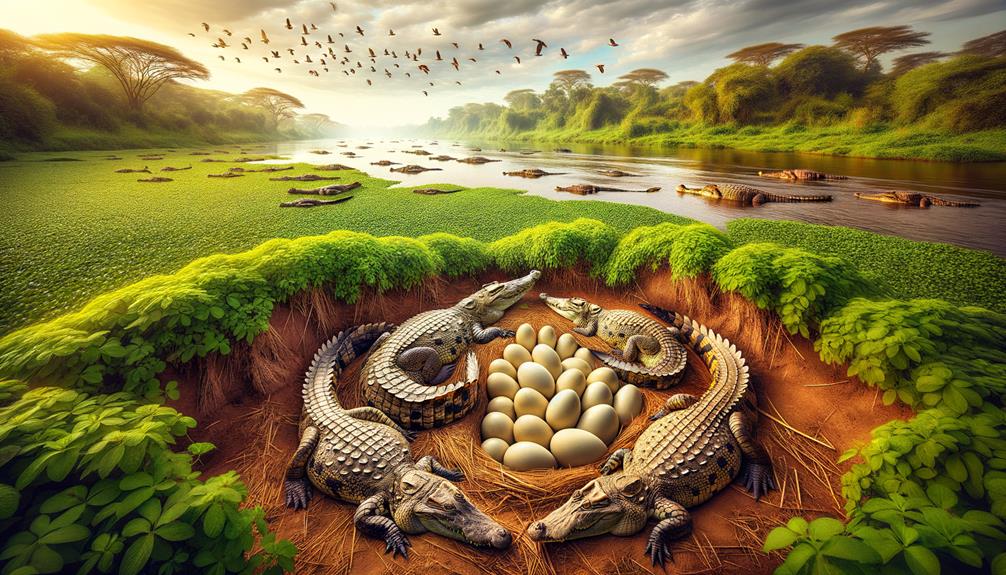I've always been drawn to Nile crocodiles, those incredible predators that dominate sub-Saharan Africa's waterways. These massive reptiles can grow up to 6.1 meters and weigh over 1,000 kilograms. You'll find them thriving in diverse freshwater habitats, from the Nile Basin to Madagascar. They're skilled hunters, feeding on everything from fish to mammals and even scavenging when needed. Their nesting behavior is equally remarkable, with females laying clutches of up to 80 eggs. Surprisingly, despite their fearsome reputation, they show a strong parental instinct. If you're interested in these formidable creatures and their interaction with humans, there's more to learn.
Key Takeaways
Nile crocodiles inhabit freshwater regions across sub-Saharan Africa, the Nile Basin, and Madagascar. They thrive in diverse ecosystems with ample water sources and demonstrate significant geographic variation in size.
Juvenile Nile crocodiles primarily consume insects and crustaceans, while adults prey on fish, birds, and mammals. These reptiles exhibit cooperative hunting strategies and can store prey underwater.
Conservation efforts aim to balance crocodile survival with human safety, given their opportunistic diet and frequent human interactions.
Physical Characteristics
When examining the physical characteristics of Nile crocodiles, it's hard not to be impressed by their massive size and distinct differences between males and females. These large reptiles typically measure between 3.5 and 5 meters in length and weigh anywhere from 225 to 750 kilograms. The largest verified specimens can exceed 6.1 meters in length and weigh over 1,000 kilograms, showcasing their intimidating presence.
Males are noticeably larger than females, with females being around 30% smaller. This size difference is a striking feature that adds to their mystique. Their thick, heavily armored skin is another defining trait, with a dark bronze color on top, adorned with faded blackish spots and stripes. The belly has a dull yellowish hue.
Juveniles have a grey, multicolored, or brown coloration, with dark cross-bands on their tails and bodies. As they mature, these bands gradually fade, giving way to their adult coloration. The relatively long snout of the Nile crocodile is equally impressive, with the largest verified skulls measuring over 65 centimeters, indicating a body length of 5.4 to 5.6 meters.
Distribution and Habitat

Nile crocodiles thrive in a wide range of freshwater habitats across sub-Saharan Africa, the Nile Basin, and Madagascar. These majestic reptiles are incredibly adaptable, making their homes in rivers, lakes, marshes, and even mangrove swamps. Their presence highlights the resilience and diversity of life in these regions.
In sub-Saharan Africa, Nile crocodiles are a common sight, spanning vast territories and showcasing significant geographic variation in their adult size. Some dwarf populations have even been identified in unlikely places like Mali and the Sahara Desert, demonstrating their astonishing adaptability. The Nile Basin offers a rich environment for these predators, with ample water sources and diverse ecosystems that support their needs.
Madagascar, with its unique biodiversity, hosts several proposed subspecies of Nile crocodiles. These population differences reflect the incredible evolutionary journey of these ancient creatures. Despite the challenges posed by their environment, Nile crocodiles continue to dominate the freshwater habitats they inhabit. Their wide distribution and varied habitats highlight their critical role in maintaining the ecological balance of these regions. It's remarkable how they conquer and thrive across such a diverse landscape.
Feeding Behavior

Nile crocodiles are apex predators that dominate aquatic and semi-aquatic habitats with their diverse and opportunistic feeding behavior. They feed on a wide array of prey, ranging from fish and birds to mammals and other reptiles. Their feeding behavior is remarkable, to say the least.
A simple table illustrates the range of their diet:
| Age Group | Primary Prey | Occasional Prey |
|---|---|---|
| Juveniles | Insects, Crustaceans | Small Vertebrates |
| Adults | Fish, Birds, Mammals | Zebras, Wildebeests |
| All Ages | Opportunistic Scavenging | Carrion, Humans |
Juvenile crocodiles start by consuming insects and crustaceans, while adults take down large prey like zebras and wildebeests. They won't hesitate to scavenge carrion or prey on humans if the opportunity arises. In large bodies of water, Nile crocodiles have been known to engage in cooperative hunting, working together to corral and capture fish. Their powerful jaws and ability to store prey underwater for later consumption solidify their status as apex predators. This adaptability in feeding behavior is a testament to their evolutionary success and dominance in their habitats.
Reproductive Patterns

Nile crocodiles' dominance as apex predators is matched by their fascinating reproductive patterns. Both parents exhibit remarkable care for their young, ensuring the continuity of their lineage. Female Nile crocodiles reach sexual maturity at over 2 meters in length, typically around age 10, while males mature between 12-19 years old. Mating takes place annually, leading to females laying clutches of up to 80 eggs in carefully constructed burrows.
The 90-day incubation period is crucial, as the temperature determines the sex of the hatchlings. Midway through this period, warmer temperatures tend to produce males, while cooler temperatures result in females. Both parents vigilantly guard the nest, an unusual but essential behavior that contributes to the species' persistence.
When it's time for the eggs to hatch, the parents gently roll them in their mouths, aiding the hatchlings' emergence. This level of parental care is extraordinary among reptiles. After hatching, the young remain with their mother for up to three months, during which her protection greatly boosts their survival odds. This intricate blend of reproductive strategy and parental care underscores the resilience and continued success of Nile crocodiles in their natural habitats.
Human Interaction

Human interactions with Nile crocodiles often have devastating consequences, highlighting the urgent need for effective conflict mitigation strategies. With an estimated 200 human fatalities annually due to crocodile attacks, these predators pose a significant threat to people living near their habitats. The overlap of crocodile-inhabiting regions with human settlements increases the likelihood of deadly confrontations.
Nile crocodiles, known for their opportunistic diet, won't hesitate to attack humans, especially when scavenging for food. Their proximity to human populations makes encounters almost inevitable, and given their size and strength, these interactions can easily turn lethal. When people engage in activities like fishing, bathing, or fetching water in crocodile-infested waters, they inadvertently put themselves at risk.
Conservation efforts are crucial, not only for the preservation of these ancient creatures but also for the safety of human populations. Strategies such as creating barriers, educating local communities, and monitoring crocodile movements can help reduce the risk of attacks. Balancing the survival of Nile crocodiles with the safety of human settlements is a complex challenge, but one that must be addressed to prevent further loss of life and promote coexistence.
Frequently Asked Questions
What Countries Do Nile Crocodiles Live In?
When I think about the vast, wild expanses of Africa, I'm reminded of Nile crocodiles. These formidable creatures inhabit countries like South Africa, Egypt, Botswana, Ethiopia, and even parts of Madagascar.
Who Eats Nile Crocodiles?
Nile crocodiles have a lot of predators to worry about. Lions, hyenas, and even other crocodiles are a threat to them. Young Nile crocodiles are especially vulnerable to birds of prey like marabou storks and Nile monitor lizards. But their biggest threat comes from humans.
Are Nile Crocodiles Aggressive?
Nile crocodiles are notorious for their aggressive behavior. Their powerful jaws and territorial nature make them a force to be reckoned with. They're apex predators, ruling their aquatic domains with an iron fist, demanding respect from all who enter their territory.
How Did Nile Crocodiles Get to Florida?
Nile crocodiles likely ended up in Florida because they escaped or were released from captivity. A genetic study confirms this, showing that all captured crocodiles are closely related, suggesting a single source of introduction. This is a concern that requires ongoing monitoring.



